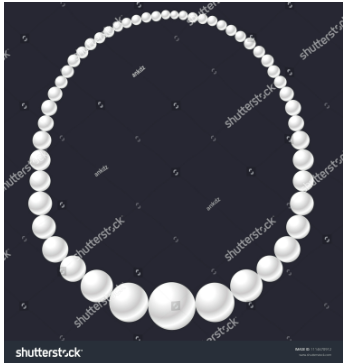Introduction
Matilda, the protagonist, is a selfish young woman. Because she was born into a family of clerks and because they could not afford a dowry, she is now married to a clerk despite having always sought a wealthy spouse. The minister’s wife and her minister’s husband are invited to a party at the minister’s home. However, Matilda lacks the fancy attire and accessories required to attend this event. Her spouse suggests she go shopping for a new outfit and contact a mutual acquaintance for some jewels. After borrowing some accessories from a pal, she heads out to the party. What happened next teaches the sad woman an important lesson.
The Necklace Short Summary
Matilda and her husband M. Loisel had an apartment and Matilda was dissatisfied and unhappy with her life. Her parents had to give her away to a board of education clerk since they couldn’t afford a dowry. Matilda was also envious of her wealthy acquaintance Mme. Jeanne Forestier, so she avoided seeing her whenever possible. She would get upset and cry for days after visiting her. When he was in office, the minister of public instruction once invited her spouse to a party at his home.

Necklace
Saddened by the fact that she’d brought absolutely nothing suitable for such an extravagant party, she left early. Her husband gave her $400 he’d been saving for a pistol so he and his buddies could go hunting. She was let down by the purchase because she couldn’t accessorise the dress with anything else she already had. Friend “Mme. Forestier,” her husband said, would be a good source for some jewels.
Mme. Loisel’s visit to her pal’s place. They were given free rein to choose whatever struck their fancy. This diamond necklace was Matilda’s choice. They then proceeded to the celebration. Soon after they left, she discovered she was missing her necklace and began to panic. When she and her husband went shopping for new jewellery, they found a comparable one for “36 000 francs,” despite his suggestion that she explain the issue to their mutual acquaintance. The good news is that M. Loisel was able to borrow the remaining funds after inheriting “18000 francs” from his father.
It took them ten years to repay all of the debts, and during that time, a lot happened. Matilda’s health declined as she was compelled to take on all of the housework. Matilda’s friend Jeanne, whom she ran into on the way, revealed that the necklace was a fake and not worth even “500 francs”
About the author
French author Henri René Albert Guy de Maupassant’ (5 August 1850 – 6 July 1893) is regarded as a master of the short story genre, and a member of the naturalist school of writers”
Conclusion
The story conveys the message that “honesty is the best policy.” If Matilda had been honest with her friend about the necklace, she would have saved herself from living a terrible life
The Necklace Question Answer
1. The course of Loisel’s life changed due to the necklace. Comment.
Ans: The Loisels had to pay back the money they borrowed to buy the jewellery over the course of ten years. It had a dramatic impact on their daily lives. They were uprooted and sent to the city’s worst neighbourhoods. Matilda had to do everything from shopping for food and bartering with the butcher and grocer on her own because she had no servants or other help. The couple’s debt forced the husband to put in long hours. The jewellery affected their lifestyle in this way.
2. What was the cause of Matilda’s ruin? How could she have avoided it?
Ans: The cause of Matilda’s downfall is her arrogance, her desire for materialistic things, and her dishonesty. By developing a sense of acceptance for her existing circumstance and satisfaction with what she had, she may have prevented it.
3. What would have happened to Matilda if she had confessed to her friend that she had lost her necklace?
Ans: Matilda could have avoided her doom if she had been honest and truthful. She would have learned that the necklace was a fake that only cost “500 francs” if she had been brave enough to tell her friend the truth about it. She wouldn’t have used her husband’s entire inheritance and taken out a loan for “18,000” to replace it. She would have saved herself and her husband from ten years of poverty.
4. If you were caught in a situation like this, how would you have dealt with it?
Ans: Above all, I would have tried to avoid falling prey to my ego and ambitions. If I had been in that position, I would have told the truth and accepted the consequences. For me, being honest was the best course of action.
Extra Questions of the Necklace Class 10
1. The Necklace: What Does It Mean?
Ans: Having to repay the debt for the necklace’s loss is a constant reminder of the life “Madame Mathilde Loisel” yearns for but can’t have, and so she wears the necklace as a reminder of that. Because of her desire to live that way, she meets an untimely death.
2. What were Loisel’s thoughts on her destiny?
Ans; Mme Loisel was the type of lady who had plenty, but she wasn’t content with it. She always believed that she was destined to enjoy all the fineries and comforts, but by some strange twist of fate, she was born into a family of clerks.
3. How does the necklace depict greed?
Ans: Mathilde picks the most expensive-looking necklace from Mme. Forestier’s jewellery box is out of greed, and the massive debt she and her husband pay to replace the lost necklace can be understood as a logical result of that greed.